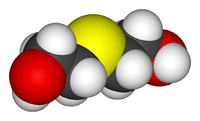Thiodiglycol
| | |
 | |
| Names | |
|---|---|
| IUPAC name
2-(2-Hydroxyethylsulfanyl)ethanol | |
| Other names
2,2'-Thiodiethanol, β,β'-dihydroxydiethyl sulfide, β-thiodiglycol, thiodiethylene glycol, β-hydroxyethyl sulfide, 2-hydroxyethyl sulfide, bis(β-hydroxyethyl)sulfide, Glyecine A, Kromfax Solvent, Tedegyl | |
| Identifiers | |
| 111-48-8 | |
| ChEBI | CHEBI:75184 |
| ChEMBL | ChEMBL444480 |
| ChemSpider | 13881956 |
| |
| Jmol-3D images | Image |
| PubChem | 5447 |
| |
| UNII | 9BW5T43J04 |
| Properties | |
| C4H10O2S | |
| Molar mass | 122.19 g/mol |
| Appearance | Clear to pale-yellow liquid |
| Melting point | −16 °C (3 °F; 257 K) |
| Boiling point | 165 °C (329 °F; 438 K) at 14 mmHg (1.9 kPa) or decomposition at 282 °C at normal pressure |
| Except where noted otherwise, data is given for materials in their standard state (at 25 °C (77 °F), 100 kPa) | |
| | |
| Infobox references | |
Thiodiglycol, or bis(2-hydroxyethyl)sulfide (also known as 2,2-thiodiethanol or TDE), is a viscous, clear to pale-yellow liquid used as a solvent. Its chemical formula is C4H10O2S, or HOCH2CH2SCH2CH2OH. It is miscible with acetone, alcohols, and chloroform. It is soluble in benzene, ether, and tetrachloromethane.
Thiodiglycol is manufactured by reaction of 2-chloroethanol with sodium sulfide. It is structurally similar to diethylene glycol.
Thiodiglycol has both polar and nonpolar solvent properties. It is used as a solvent in a variety of applications ranging from dyeing textiles to inks in some ballpoint pens. In chemical synthesis, it is used as a building block for protection products, dispersants, fibers, plasticizers, rubber accelerators, pesticides, dyes, and various other organic chemicals. In the manufacture of polymers, it is used as a chain transfer agent. As an antioxidant, it is used as an additive in lubricants.
A relatively recent use (as of 2006) of thiodiglycol is as a mounting medium in microscopy. The ability to vary the refractive index of the medium by varying the concentration of TDE in an aqueous solution, plus its relative lack of toxicity makes it highly desirable for such use. The refractive index of the solution can be varied anywhere from near that of water (1.333) to that of glass (1.518).[1]
Thiodiglycol is a Chemical Weapons Convention schedule 2 chemical used in the production of sulfur-based blister agents such as mustard gas. Thiodiglycol is also a product of the hydrolysis of mustard gas. It can be detected in the urine of casualties.
References
- ↑ Staudt T et al. (2006). "2,2′-Thiodiethanol: A new water soluble mounting medium for high resolution optical microscopy". Microscopy Research and Technique 70: 1–9. doi:10.1002/jemt.20396.